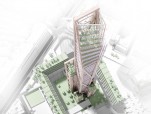Alternative Architecture

The article deals with the unique project of 300-meter height wooden skyscraper. The tower was designed for the central part of London, as an iconic and sustainable building. The designs for the Barbican is the first in series of timber skyscrapers developed by Cambridge University in association with globally renowned architects and structural engineers with funding from the UK’s Engineering and Physical Sciences Research Council.
Just as major innovations in steel, glass, concrete revolutionized buildings in the 19th and 20th centuries, creating new typologies such as Joseph Paxton’s Crystal Palace and the Parisian arcades described by Walter Benjamin, innovations in timber construction could lead to entirely new experiences of the city in the 21st century. The use of timber as a structural material in tall buildings is an area of emerging interest for its variety of potential benefits; the most obvious being that it is a renewable resource, unlike prevailing construction methods which use concrete and steel. The research is also investigating other potential benefits, such as reduced costs and improved construction timescales, increased fire resistance, and significant reduction in the overall weight of buildings. The timber structure would be four times lighter than its concrete equivalent.
Full content of this issue you can read here
The full version of the article can be read in our printed issue, also you can subscribe to the web-version of the magazine
 Materials provided by PLP Architecture
Materials provided by PLP Architecture


